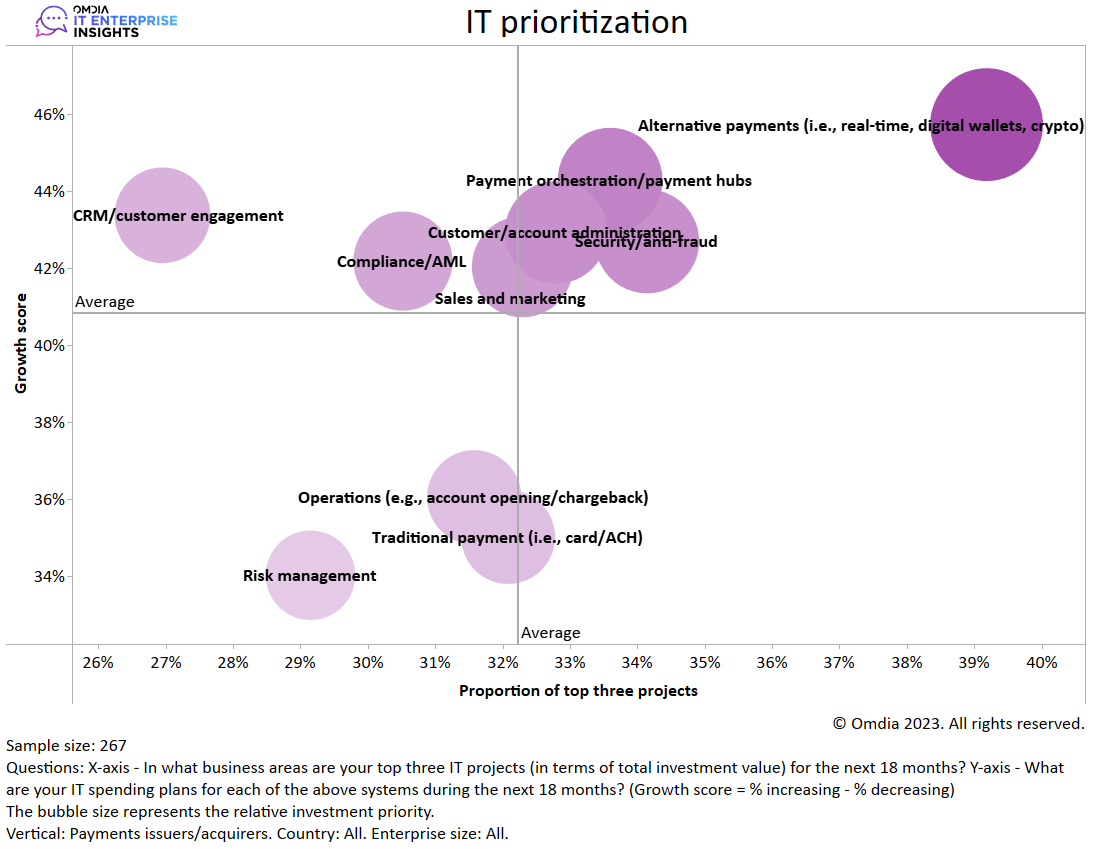State of play: payments
Each month, Philip Benton, Principal Fintech Analyst at Omdia, explores a new topic and assesses the “state of play”, providing an analysis and understanding of the market landscape.
This month, Philip takes an in-depth look at payments.
It’s no secret that payments is my favourite aspect of fintech.
Judging the PayTech Awards is one of the highlights of my year as I get an early glimpse at how the landscape will change.
I’ve covered the space for over a decade, and the progression of the technology has kept me fascinated. The shift from paper-based to card-based payments and subsequently physical to digital payments reflects how society has evolved.
However, the cultural and habitual factors of payments are always underestimated, hence why a wider shift to a new payment method initially appears slow before seemingly snowballing.
Today, consumers have more options than ever to make payments. So which method will ultimately win? Let’s dive in.
The rise of alternative payments prompts investment in payment orchestration
While there is no suggestion that traditional payments like card, ACH or even cash will disappear anytime soon, the success of open banking in the UK and Europe and real-time payment rails UPI and Pix have led to global interest, with more countries looking to adopt alternative payments to digitalise economies.
According to the Omdia 2024 Trends to Watch: Payments report, more than a third of payment issuers and acquirers listed alternative payments (instant payments, digital wallets and cryptocurrencies) in their top-three IT projects for the next 18 months.

Image source: Omdia
The vast increase in payment methods that consumers are now demanding has necessitated the need for a modern payment orchestration platform to ensure seamless routing and processing. In fact, 58% of issuers/acquirers plan to increase their spend on payment orchestration/payment hubs, including 25% of respondents who will be increasing spend by 6% or more.
However, payments are inherently habitual, so shifting consumer preference towards alternatives to drive mass adoption of newer payment methods requires the entire payment ecosystem to increase education and awareness to ensure consumers are comfortable and familiar.
The user experience has to be a vast improvement on their default payment method and should not only be easier and more convenient, but should also maintain the same (if not higher) level of security.
Digital wallets key to broader adoption of alternative payments
Digital wallets were initially introduced to replicate physical wallets in an online environment, and thus acted as a layer on top of existing payment methods i.e. debit and credit cards. The roll out of QR codes in Asia and near-field communication (NFC) technology in Europe and North America saw mobile digital wallets take off as an in-store payment method.
Digital wallets have since become the world’s leading payment method for both e-commerce and POS transactions, according to Worldpay’s Global Payments Report 2023, and are forecast to account for 54% of e-commerce payments and 43% of POS transactions by 2026.
Issuer banks have recognised the threat posed by non-traditional rivals and in turn have used digital wallets as a spur to accelerate their own customer acquisition. Although integrating third-party digital wallets is important for merchants and acquirers, issuer banks are looking to compete directly with Big Tech (i.e. Apple Pay and Google Pay) at the checkout.
Early Warning Services, the US bank consortium, is set to launch its e-commerce-only digital wallet Paze in Q1 2024 and will not charge any fees to merchants for at least the next few years. After customers authenticate themselves and get access to the wallet, Paze also “pre-selects” the cards it thinks are most relevant for the consumer based on their historical e-commerce behaviour. Participating institutions include Early Warning’s co-owners Bank of America, Truist, Capital One, JP Morgan Chase, PNC Bank, US Bank and Wells Fargo, which encompasses around 150 million cardholders.
Similarly, the European Payments Initiative (EPI) is launching its digital wallet solution ‘wero’ by mid-2024. It will launch initially in Belgium, France and Germany followed by the Netherlands, with the aim to extend to other countries in the years to come.
As new payment methods emerge, such as central bank digital currencies (CBDCs) and “pay by bank,” a common platform is needed to flourish, and digital wallets fit the bill as they already have high adoption rates. Digital identity is increasingly a focus of sovereign governments and digital wallets again can be the vehicle to ensure a successful rollout.
Open banking will be the catalyst for digital identity adoption
Open banking as a concept is almost six years old, and in that time, payment issuers and acquirers have been focused on introducing new open banking-powered payment services (i.e. Pay by Bank) that have grown in popularity to serve niche segments, such as the luxury and hospitality sectors.
There is evidence that markets which were initially regulatory-driven are beginning to experiment with innovative services on top of the established infrastructure. For the first time in Omdia’s annual payments survey, ‘providing digital identity services’ is the top open banking opportunity as selected by over a third of payment issuers/acquirers surveyed by Omdia.
The exponential growth of digital services has also caused a surge in online scams and fraud with many legislators calling for a digital identity document to be used for payments, other financial services and storing digital documents. The European Union is currently in the process of creating a digital identity document of its own, seemingly not trusting the existing Big Tech sign-in methods to be secure enough as a link to a government ID.
As we embrace a new world where data is more freely available, digital identity is going to be fundamental to unlocking new segments of the market and ensuring consumers and businesses can better access, manage and ultimately grow their finances.
CX is driving payment infrastructure investment
Although a plethora of new and innovative payment methods have emerged as an alternative to traditional payments, adoption has been slower than anticipated. This is in part due to an inconsistent and unreliable customer experience (CX) that doesn’t incentivise consumers to change behaviour.
Brazil’s Pix and India’s UPI have become the blueprints of how to roll out new payment methods, with collaboration between all stakeholders (government, merchants, payment issuers/acquirers) vital to ensure strong adoption.
Open banking payments, while still in the nascent phase, have generally struggled to be adopted by consumers due to an inconsistent user experience. The user experience varies significantly depending on the bank, merchant and open banking provider. The APImetrics report on UK open banking API performance in 2022–23 found there was a six-times difference in total latency between the fastest and slowest banks, which is a big barrier to universal adoption.
However, I remain bullish on the future of open banking payments. Contactless technology and digital wallets took many years to establish themselves as the norm, and the same will happen for open banking payments for certain use cases.
Ultimately, I am anticipating more payment methods to emerge. The ones that survive and subsequently thrive will be because they reflect the current and future needs of society at large.
About the author
 Philip Benton is a Principal Fintech Analyst at Omdia and writes analysis on the issues driving technological change in financial services. Prior to Omdia, he led consumer trends research in retail and payments at strategic market research firm Euromonitor.
Philip Benton is a Principal Fintech Analyst at Omdia and writes analysis on the issues driving technological change in financial services. Prior to Omdia, he led consumer trends research in retail and payments at strategic market research firm Euromonitor.
In this column, Philip will discuss the technological implications and consumer expectations of the latest fintech trends.
You can find more of Philip’s views on fintech via LinkedIn or follow him on Twitter @bentonfintech.










































